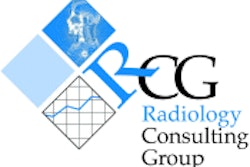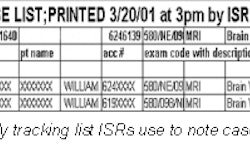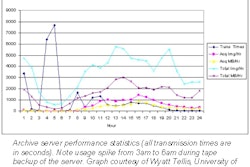
Philips Medical Systems rates the highest in PACS performance among customers, according to a report issued by research and consulting firm KLAS of Draper, UT. KLAS recently completed a customer survey of 143 healthcare institutions that are using PACS networks from eight different vendors.
PACS networks installed by Agfa, Canon Medical Systems, DR Systems, GE Medical Systems, Kodak Health Imaging, Marconi Medical Systems, Philips, and Siemens Medical Solutions were surveyed. Other vendors, including Fujifilm Medical Systems, ALI Technologies, eMed Technologies, Emageon, Stentor, Brit Systems, and Inphact were not surveyed in the report, but may be included in a future update, according to KLAS.
The participating vendors supplied KLAS with their key customer lists, which contributed the majority of surveyed clients. KLAS also surveyed additional installations referred by the vendor-provided institutions. The number of sites surveyed per vendor ranged from 15 to 21. The customers represented a broad cross-section of PACS users, ranging from 10% up to 95% filmless, with large-scale users making up the majority of respondents, according to KLAS.
Each of the customers were asked to numerically rate their vendor on 28 aspects of their performance, as well as answer 13 questions relating to customer satisfaction. Based on 28 numeric performance indicators, KLAS calculated the following overall rankings:
- Philips
- DR Systems
- GE
- Marconi
- Agfa
- Siemens
- Kodak
- Canon
While the primary purpose of the study was to rank the PACS vendors, KLAS also analyzed the responses to learn more about customers' reasons for implementing PACS, as well as factors that led to the success of digital image management. Film reduction, cost reduction, and increased productivity were the most commonly realized quantifiable benefits of PACS. Least common was improved patient care, physician satisfaction, and faster transcription.
Quantifiable Benefits of a PACS as reported by clients:
- 18%: film reduction
- 17%: cost reduction
- 16%: increased productivity
- 12%: faster image distribution/turnover
- 11%: reduction of lost film
- 8%: staff reduction
- 7%: easy access/display of images
- 5%: improved patient care
- 4%: physician satisfaction
- 2%: faster transcription
Customers chose their PACS vendor most often because of relationship/partnering, price, and functionality/ease of use, with 20%, 17%, and 16% of sites (see chart below).
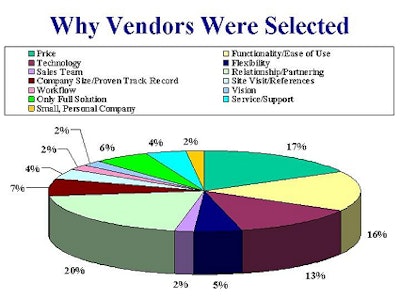 |
Survey respondents cited a company's size and/or track record as the most common reason for not buying its PACS, with this category generating 31% of responses. Technology and price followed, with 12% and 11%, respectively.
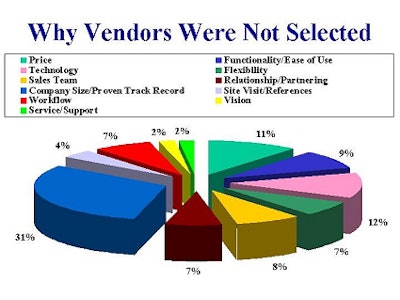 |
In reviewing common ground between successful PACS installations among all vendors, planning and teamwork were paramount, according to regional director Norm Swaton. After a prospective purchaser determines what it wishes to accomplish with the technology, it's critical to involve everyone who would be affected by the PACS, such as administration, radiology staff, clinical staff, technologists, and IT staff, he said.
"Buy-in must occur at every level to be successful," Swaton said. "We had one site that had some money left over from Y2K and used it to buy PACS, without doing a lot of planning and consulting with other departments. This installation was going to fail from the start."
The most successful PACS sites reported using a prepurchasing team that included representatives from radiology, IS, and administration. After a vendor was selected, a vendor representative joined the team, which met on a weekly or biweekly basis, to plan implementation and training, he said.
Users that were cognizant of the differences between digital and film-based departments also were most successful, Swaton said. With PACS, the physical layout of the radiology department may change, as may the responsibilities of radiology staff.
"There are tremendous differences between film and digital workflow," he said. "And if they didn't plan for this change in the workflow processes, they had trouble."
As might be expected, enterprise-wide PACS users reported the most success with their installations, said KLAS senior vice president Ralph Reyes.
"Anywhere an image is needed, successful systems could push, pull, or otherwise get that information to the physician," he said.
The full 256-page report is available to healthcare providers for $985. More information is available at the KLAS' Web site: www.healthcomputing.com.
By Erik L. RidleyAuntMinnie.com staff writer
July 13, 2001
Related Reading
Swift move to filmless radiology can pay dividends, July 9, 2001
Proper training can reduce errors in PACS implementation, July 4, 2001
PACS/RIS integration saves time and money, June 1, 2001
PACS quality control ensures that exams get read, May 30, 2001
Copyright © 2001 AuntMinnie.com




